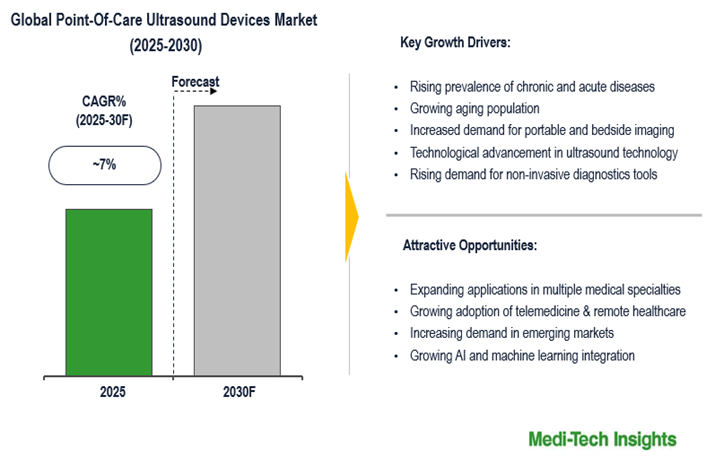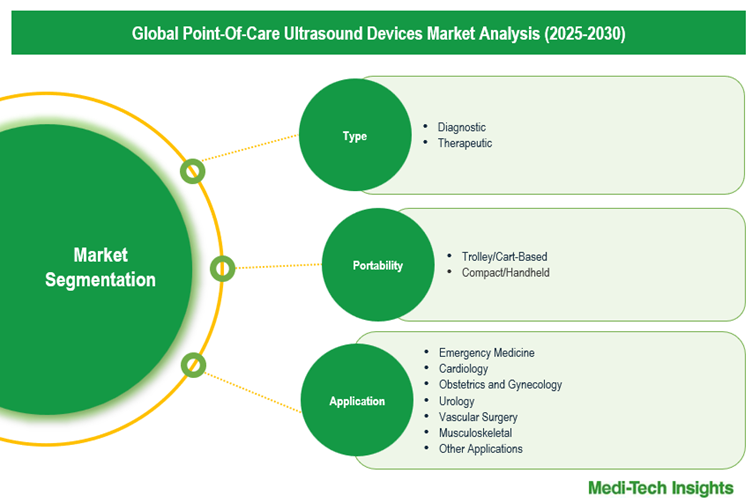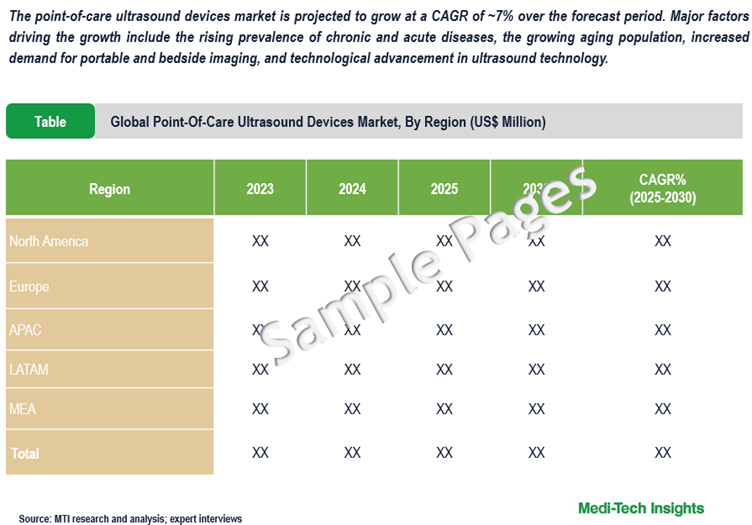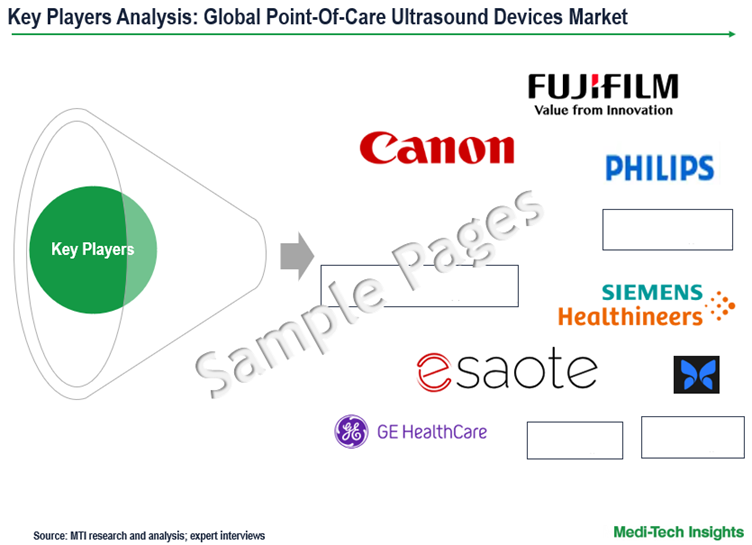
Global Point-Of-Care Ultrasound Devices Market Size & Trends Report Segmented by Type (Diagnostics, Therapeutics), Portability (Trolley/Cart-Based, Compact/Handheld), Application (Emergency Medicine, Cardiology, Musculoskeletal), End User & Regional Forecast to 2030
The point-of-care ultrasound devices market is projected to grow at a CAGR of ~7% over the forecast period. Major factors driving the growth include the rising prevalence of chronic and acute diseases, the growing aging population, increased demand for portable and bedside imaging, technological advancement in ultrasound technology, and rising demand for non-invasive diagnostics tools. However, the market encounters challenges, including the high cost of point-of-care ultrasound devices, stringent regulatory approvals and reimbursement limitations, and a lack of skilled professionals. To learn more about the research report, download a sample report.
Report Overview
Point-of-care ultrasound (POCUS) diagnostic devices are portable imaging systems designed for bedside use or real-time clinical applications, providing immediate diagnostic and procedural guidance. These devices enable clinicians to make rapid, informed decisions, making them invaluable across multiple medical specialties. Widely utilized in emergency rooms, ICUs, and by mobile specialists such as anesthesiologists and orthopedists, POCUS allows for quick visualization of internal organs, blood flow, and soft tissues. This enhances the detection of conditions like fluid accumulation, organ damage, and vascular abnormalities, reinforcing its role as a critical tool in modern healthcare.

To learn more about the research report, download a sample report.
Rising demand for portable and bedside imaging in emergency settings drives POCUS adoption
Point-of-care ultrasound (POCUS) is a versatile diagnostic tool applicable across various healthcare settings. However, its ease of use and rapid imaging capabilities make it particularly valuable in emergency medicine. In emergency rooms (ERs), intensive care units (ICUs), and ambulances, quick and accurate imaging is essential for identifying life-threatening conditions such as internal bleeding, cardiac arrest, and respiratory complications. Here are some key emergency applications of POCUS across different specialties, including trauma, critical care, musculoskeletal (MSK), and anesthesia:
- Trauma: The FAST (Focused Assessment with Sonography for Trauma) exam helps rapidly detect internal hemorrhage in trauma patients, enabling timely surgical intervention
- Lung Ultrasound: In ventilated patients in critical care, POCUS aids in diagnosing pneumonia, pleural effusion, and pulmonary edema without radiation exposure
- Undifferentiated Shock: POCUS assists in differentiating between major shock types, including distributive, hypovolemic, and obstructive shock, guiding appropriate treatment
- Cardiac Arrest: At the bedside, POCUS facilitates rapid cardiac assessments, improving response times in cardiac arrest scenarios. It helps distinguish between pulseless electrical activity (PEA) with or without cardiac motion, informing resuscitation strategies
- Procedural Guidance: POCUS enhances the accuracy of invasive procedures, including vascular access, airway management, and nerve blocks, reducing complications and improving patient safety
The growing need for portable, bedside imaging in emergency and critical care settings continues to drive the demand for POCUS devices, making them an indispensable tool in modern healthcare.

To learn more about the research report, download a sample report.
Advancements in ultrasound technologies fuel its demand
Ultrasound technology plays a vital role in clinical diagnosis and management. Innovations in portability, image quality, artificial intelligence (AI), and wireless connectivity have expanded the usability of ultrasound in various medical settings, enhancing diagnostic accuracy and efficiency.
- Artificial Intelligence (AI) integration in ultrasound imaging: The incorporation of AI in ultrasound devices has introduced intelligent evaluation capabilities, enhanced image quality, and streamlined screening, acquisition, analysis, and data processing. This advancement allows ultrasound operators to skip complex image optimization and measurement steps, enabling them to concentrate on clinical diagnosis and patient care
- Miniaturization and Portability: Traditional ultrasound machines were large and limited to radiology departments. The advancement of handheld and pocket-sized POCUS devices now allows imaging at the bedside, in ambulances, and even in remote locations. Wireless and battery-powered models enhance mobility, making ultrasound more accessible to emergency responders, primary care physicians, and field clinicians
- Tele-remote and 5G networks: Tele-remote ultrasound enables real-time remote diagnosis and interventional procedures through high-precision synchronization using video, audio, text, and other communication channels. These advancements are further accelerated by the emergence of 5G technology, which facilitates long-distance, real-time imaging with high bandwidth, high resolution, and low latency, supporting remote ultrasound consultations and robotic-assisted operations
Competitive Landscape Analysis
The global point-of-care ultrasound devices market is marked by the presence of established and emerging market players such as GE Healthcare; Koninklijke Philips; Siemens Healthineers; Canon Medical Systems Corporation; Esaote SpA; Fujifilm Holdings Corp.; Mindray; Samsung Electronics Co. Ltd.; BenQ Medical Technology; and Butterfly Network, Inc. among others. Some of the key strategies adopted by market players include new product development, strategic partnerships and collaborations, and investments.
Report Scope
|
Report Scope |
Details |
|
Base Year Considered |
2024 |
|
Historical Data |
2023 – 2024 |
|
Forecast Period |
2025 – 2030 |
|
Growth Rate |
~7% |
|
Market Drivers |
|
|
Attractive Opportunities |
|
|
Segment Scope |
Type, Portability, Application, and End User |
|
Regional Scope |
|
|
Key Companies Mapped |
GE Healthcare; Koninklijke Philips; Siemens Healthineers; Canon Medical Systems Corporation; Esaote SpA; Fujifilm Holdings Corp.; Mindray; Samsung Electronics Co. Ltd.; BenQ Medical Technology; and Butterfly Network, Inc. |
|
Report Highlights |
Market Size & Forecast, Growth Drivers & Restraints, Trends, Competitive Analysis |
Market Segmentation
This report by Medi-Tech Insights provides the size of the global point-of-care ultrasound devices market at the regional- and country-level from 2023 to 2030. The report further segments the market based on type, portability, application, and end user.
- Market Size & Forecast (2023-2030), By Type, USD Million
- Diagnostic
- Therapeutic
- Market Size & Forecast (2023-2030), By Portability, USD Million
- Trolley/Cart-Based
- Compact/Handheld
- Market Size & Forecast (2023-2030), By Application, USD Million
- Emergency Medicine
- Cardiology
- Obstetrics and Gynecology
- Urology
- Vascular Surgery
- Musculoskeletal
- Other Applications
- Market Size & Forecast (2023-2030), By End User, USD Million
- Hospitals
- Diagnostics Imaging Center
- Research Laboratories
- Others
- Market Size & Forecast (2023-2030), By Region, USD Million
- North America
- US
- Canada
- Europe
- UK
- Germany
- France
- Italy
- Spain
- Rest of Europe
- Asia Pacific
- China
- India
- Japan
- Rest of Asia Pacific
- Latin America
- Middle East & Africa
- North America
Key Strategic Questions Addressed
- What is the market size & forecast of the point-of-care ultrasound devices market?
- What are the historical, present, and forecasted market shares and growth rates of various segments and sub-segments of the point-of-care ultrasound devices market?
- What are the key trends defining the market?
- What are the major factors impacting the market?
- What are the opportunities prevailing in the market?
- Which region has the highest share in the global market? Which region is expected to witness the highest growth rate in the next 5 years?
- Who are the major players operating in the market?
- What are the key strategies adopted by players?
- Introduction
- Introduction
- Market Scope
- Market Definition
- Segments Covered
- Regional Segmentation
- Research Timeframe
- Currency Considered
- Study Limitations
- Stakeholders
- List of Abbreviations
- Key Conferences and Events (2025-2026)
- Research Methodology
- Secondary Research
- Primary Research
- Market Estimation
- Bottom-Up Approach
- Top-Down Approach
- Market Forecasting
- Executive Summary
- Point-Of-Care Ultrasound Devices Market Snapshot (2025-2030)
- Segment Overview
- Regional Snapshot
- Competitive Insights
- Market Overview
- Market Dynamics
- Drivers
- Rising prevalence of chronic and acute diseases
- Growing aging population
- Increased demand for portable and bedside imaging
- Technological advancement in ultrasound technology
- Rising demand for non-invasive diagnostics tools
- Restraints
- High cost of point-of-care ultrasound devices
- Lack of skilled professionals
- Regulatory and reimbursement challenges
- Opportunities
- Expanding applications in multiple medical specialties
- Growing adoption of telemedicine & remote healthcare
- Increasing demand in emerging markets
- Growing AI and machine learning integration
- Key Market Trends
- Shifting towards miniaturization & handheld ultrasound devices
- Increased AI automation in image interpretation
- Adoption of personalized & wearable ultrasound technology
- Unmet Market Needs
- Industry Speaks
- Global Point-Of-Care Ultrasound Devices Market Size & Forecast (2023-2030), By Type, USD Million
- Introduction
- Diagnostic
- Therapeutic
- Global Point-Of-Care Ultrasound Devices Market Size & Forecast (2023-2030), By Portability, USD Million
- Introduction
- Trolley/Cart-Based
- Compact/Handheld
- Global Point-Of-Care Ultrasound Devices Market Size & Forecast (2023-2030), By Application, USD Million
- Introduction
- Emergency Medicine
- Cardiology
- Obstetrics and Gynecology
- Urology
- Vascular Surgery
- Musculoskeletal
- Other Applications
- Global Point-Of-Care Ultrasound Devices Market Size & Forecast (2023-2030), By End User, USD Million
- Introduction
- Hospitals
- Diagnostics Imaging Centers
- Research Laboratories
- Others
- Global Point-Of-Care Ultrasound Devices Market Size & Forecast (2023-2030), By Region, USD Million
- Introduction
- North America Point-Of-Care Ultrasound Devices Market Size & Forecast (2023-2030), By Country, USD Million
- US
- Market Size & Forecast, By Type (USD Million)
- Market Size & Forecast, By Portability (USD Million)
- Market Size & Forecast, By Application (USD Million)
- Market Size & Forecast, By End User (USD Million)
- Canada
- Market Size & Forecast, By Type (USD Million)
- Market Size & Forecast, By Portability (USD Million)
- Market Size & Forecast, By Application (USD Million)
- Market Size & Forecast, By End User (USD Million)
- US
- Europe Point-Of-Care Ultrasound Devices Market Size & Forecast (2023-2030), By Country, USD Million
- UK
- Market Size & Forecast, By Type (USD Million)
- Market Size & Forecast, By Portability (USD Million)
- Market Size & Forecast, By Application (USD Million)
- Market Size & Forecast, By End User (USD Million)
- Germany
- Market Size & Forecast, By Type (USD Million)
- Market Size & Forecast, By Portability (USD Million)
- Market Size & Forecast, By Application (USD Million)
- Market Size & Forecast, By End User (USD Million)
- France
- Market Size & Forecast, By Type (USD Million)
- Market Size & Forecast, By Portability (USD Million)
- Market Size & Forecast, By Application (USD Million)
- Market Size & Forecast, By End User (USD Million)
- Italy
- Market Size & Forecast, By Type (USD Million)
- Market Size & Forecast, By Portability (USD Million)
- Market Size & Forecast, By Application (USD Million)
- Market Size & Forecast, By End User (USD Million)
- Spain
- Market Size & Forecast, By Type (USD Million)
- Market Size & Forecast, By Portability (USD Million)
- Market Size & Forecast, By Application (USD Million)
- Market Size & Forecast, By End User (USD Million)
- Rest of Europe
- Market Size & Forecast, By Type (USD Million)
- Market Size & Forecast, By Portability (USD Million)
- Market Size & Forecast, By Application (USD Million)
- Market Size & Forecast, By End User (USD Million)
- UK
- Asia Pacific (APAC) Point-Of-Care Ultrasound Devices Market Size & Forecast (2023-2030), By Country, USD Million
- China
- Market Size & Forecast, By Type (USD Million)
- Market Size & Forecast, By Portability (USD Million)
- Market Size & Forecast, By Application (USD Million)
- Market Size & Forecast, By End User (USD Million)
- Japan
- Market Size & Forecast, By Type (USD Million)
- Market Size & Forecast, By Portability (USD Million)
- Market Size & Forecast, By Application (USD Million)
- Market Size & Forecast, By End User (USD Million)
- India
- Market Size & Forecast, By Type (USD Million)
- Market Size & Forecast, By Portability (USD Million)
- Market Size & Forecast, By Application (USD Million)
- Market Size & Forecast, By End User (USD Million)
- Rest of Asia Pacific
- Market Size & Forecast, By Type (USD Million)
- Market Size & Forecast, By Portability (USD Million)
- Market Size & Forecast, By Application (USD Million)
- Market Size & Forecast, By End User (USD Million)
- China
- Latin America (LATAM) Point-Of-Care Ultrasound Devices Market Size & Forecast (2023-2030), USD Million
- Market Size & Forecast, By Type (USD Million)
- Market Size & Forecast, By Portability (USD Million)
- Market Size & Forecast, By Application (USD Million)
- Market Size & Forecast, By End User (USD Million)
- Middle East & Africa (MEA) Point-Of-Care Ultrasound Devices Market Size & Forecast (2023-2030), USD Million
- Market Size & Forecast, By Type (USD Million)
- Market Size & Forecast, By Portability (USD Million)
- Market Size & Forecast, By Application (USD Million)
- Market Size & Forecast, By End User (USD Million)
- Competitive Landscape
- Key Players and their Competitive Positioning
- Key Player Comparison
- Segment-wise Player Mapping
- Market Share Analysis (2024)
- Company Categorization Matrix
- Dominants/Leaders
- New Entrants
- Emerging Players
- Innovative Players
- Key Strategies Assessment, By Player (2022-2025)
- New Product Launches
- Partnerships, Agreements, & Collaborations
- Mergers & Acquisitions
- Geographic Expansion
- Key Players and their Competitive Positioning
- Company Profiles* (Business Overview, Financial Performance**, Products Offered, Recent Developments)
- GE Healthcare
- Koninklijke Philips
- Siemens Healthineers
- Canon Medical Systems Corporation
- Esaote SpA
- Mindray
- Fujifilm Holdings Corporation
- Samsung Electronics Co. Ltd.
- Butterfly Network
- BenQ Medical Technology
- Other Prominent Players
Note: *Indicative list
**For listed companies
The study has been compiled based on extensive primary and secondary research.
Secondary Research (Indicative List)

Primary Research
To validate research findings (market size & forecasts, market segmentation, market dynamics, competitive landscape, key industry trends, etc.), extensive primary interviews were conducted with both supply and demand-side stakeholders.
Supply Side Stakeholders:
- Senior Management Level: CEOs, Presidents, Vice-Presidents, Directors, Chief Technology Officers, Chief Commercial Officers
- Mid-Management Level: Product Managers, Sales Managers, Brand Managers, R&D Managers, Business Development Managers, Consultants
Demand Side Stakeholders:
- Stakeholders from Hospitals, Diagnostics Imaging Centers, Research Laboratories, and Others
Breakdown of Primary Interviews

Market Size Estimation
Both ‘Top-Down & Bottom-Up Approaches’ were used to derive market size estimates and forecasts.
Data Triangulation
Research findings derived through secondary sources & internal analysis were validated with Primary Interviews, the Internal Knowledge Repository, and the Company’s Sales Data.



